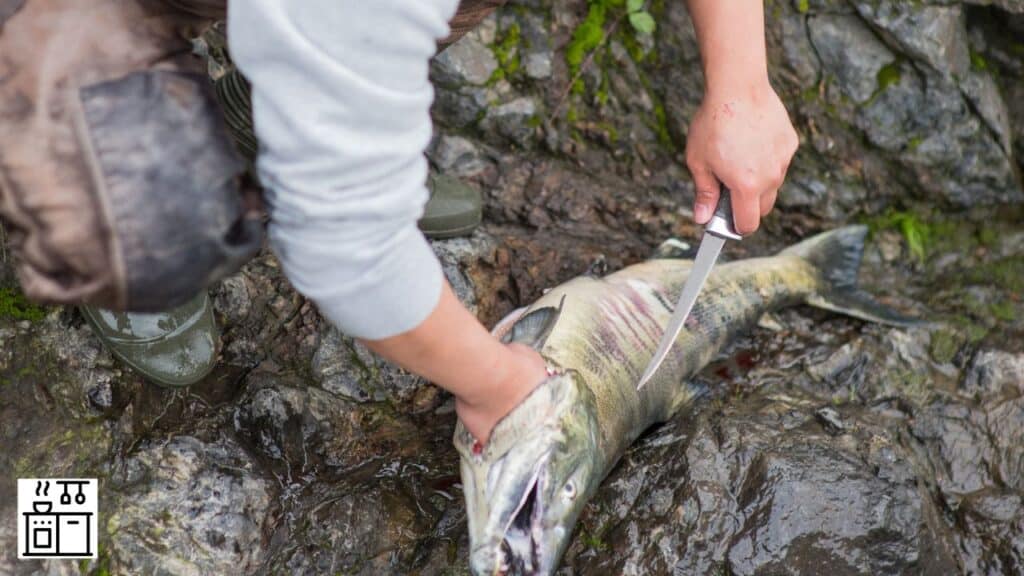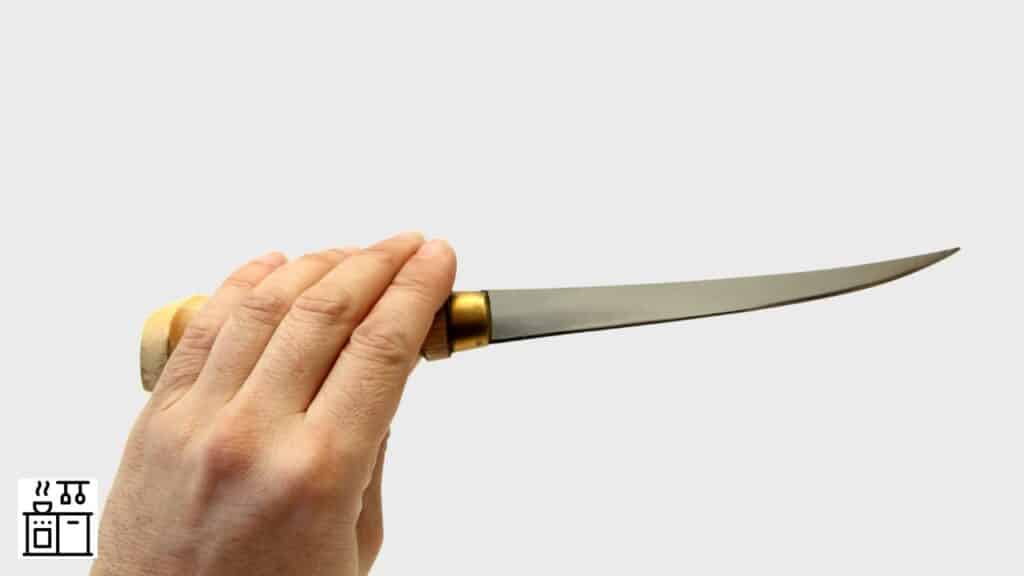Unlike other types of meat, fish is delicate and needs careful handling.
That’s why it’s important to use the right tool to cut it.
This is where a fillet knife comes into the picture.
So…
What Exactly Is a Fillet Knife?
Fillet knives are specially designed for cutting fish and removing fish bones.
They have flexible but strong and have long serrated blades to do a clean and precise job.
The blades of fillet knives are usually 17 to 21cm long.
Due to their unique design, you can easily slide these knives along the middle bone of a fish and remove the skin without wasting any flesh.
Parts of A Fillet Knife
Fillet knives have two main parts: the blade and the handle.
Let’s take a look at each of these parts.
Blade
The most important feature of a fillet knife is its curved blade.
The purpose of this curved blade is to increase the cutting area.
This unique shape reduces drag, and so you will experience less friction when making an incision.
The non-curved side of the fillet blade is called the spine. It’s not sharp, and you can’t cut fish using this side.
However, you can use it for descaling.
Most fillet knives have serrated blades.
The fine teeth on the blade make it easy to cut through the flesh and skin.
It reduces the resistance of cutting by making tiny tears along the length.
The edge of a fillet knife is sharp and pointed. This pointed design makes it useful for puncturing the skin.
Different materials are used to construct the blade of fillet knives.
However, the most popular choice is stainless steel because it’s rust-proof and durable.
Other common metals and alloys include carbon steel and iron.
Handle
The handle of a fillet knife is just as important as the blade because it decides the ease of using the knife.
The handle can be made of wood, rubber, polymer, or metal.
In some fillet knives, the blade extends along the entire length of the knife.
In this case, the base of the blade is concealed inside the handle. Such blades are said to be full tang.
The alternative is where the cutting blade ends just a few inches beyond the handle.
These blades are inserted into a groove in the handle and locked in place.
Fillet knives with full tang are generally more comfortable to handle because they balance better in the palm.
This makes it easy to use the fillet knife.
Most manufacturers design the handle to slightly protrude where the blade begins.
This reduces the chances of injury and protects hands by providing a better grip if the knife slips.
Important Factors to Consider when Choosing a Fillet Knife
There are a variety of fillet knife designs available in the market.
The differences are usually in the quality of metal used for the blade, type of handle, dimensions, and weight.
To choose the right type of fillet knife, consider the following factors.
Construction Material
Carbon steel and stainless steel are the two materials used for constructing the blade of a fillet knife.
Carbon steel is sharp and stronger than stainless steel. However, it’s corrosion-prone.
A stainless steel blade lasts longer but isn’t as strong or efficient.
Size of The Blade

A 6 to 8-inch blade is usually comfortable to handle for most cooks.
However, fillet knives with longer and shorter blades are also available.
Curve of The Blade
Fillet knives will always have curved blades.
The curvature of the blade, however, varies slightly from one brand to another.
Some knives are more curved than others.
When choosing the curvature of the blade, remember that the more curved the blade is, the better it will fillet the fish.
However, curved blades are more difficult to sharpen because of their shape.
Handle Design and Material
A full-tang knife is robust and balances better than a knife with a partial tang.
However, the choice depends on your personal style.
If you prefer a lighter knife, a partial tang will suit you better.
Similarly, the material used for the handle can vary.
You can choose between wood, metal, rubber, and polymer according to your preferences.
Wooden handles generally require more maintenance. Metal and polymer are easy to clean and maintain.
When choosing a fillet knife, you should always hold it and see how the knife sits in your hand.
Those with ergonomic grooves are usually more comfortable to use.
However, they may not be as attractive as knives without finger grooves.
How to Use a Fillet Knife to Cut Fish?
Filleting a fish is an easy task when you have the right knife for the job.
Your fillet knife should also be sharp to do the task quickly and efficiently.
One fish will yield two fillets. The portion above the bone forms one fillet, while the piece below the bone forms the second.
Before cutting the fish open, it’s important to remove the scales.
You will be unable to descale a fish after cutting it open.
You can descale the fish by using the blunt edge of a fillet knife.
Run it close to the skin in the opposite direction of the scales to dislodge them.
Do this for the entire length of the fish to separate all the scales.
Then, run the fish under water to get rid of the scales.
The next step is to remove the internal organs of the fish since these aren’t used for cooking.
Use a scissor to cut below the head of the fish, from the gills to the tail. Then, pull them out.
Next, clean the carcass with water to get rid of the sticky bits and blood.
After removing the guts and scales, you can now fillet the fish.
Slide the fillet knife behind the gills and along the backbone. Then, slice the fish all the way down to the tail.
Be careful while working around the ribs.
You can twist the knife to cut the fish off the bone without wasting any flesh.
Slowly lift the fillet from the bone and put it aside.
Repeat the same process with the other side to get your second fillet.
Related: Differences Between a Fillet and Boning Knife
How to Take Care of A Fillet Knife?
The fillet knife is useful only when it’s sharp and in good condition. When the blade is dull, it’s difficult to fillet fish.
The flesh will become bruised and not be presentable.
Hence, it’s important to maintain a fillet knife to keep it in optimal working condition.
With proper care, you can keep the blade sharp, and the knife will serve you for several years.
Always clean the knife immediately after use and dry it thoroughly to prevent the blade from becoming dull.
We don’t advise washing fillet knives in the dishwasher since it reduces the lifespan of the knife.
Regardless of how well you care for a fillet knife, it will lose its sharpness over time.
Fortunately, you can restore it by sharpening the blade.
The easiest way to sharpen a fillet knife is by using a whetstone.
Hold the blade at an angle and run the sharp edge along the whetstone a few times.
Do this gradually to shave the dull metal at the edge. This will make the knife sharp again.
However, sharpening a fillet knife on a whetstone shaves the metal off the blade and makes it thin.
So we don’t recommend sharpening it too frequently.
By taking good care of the knife between uses, it will remain sharp for much longer.
If you don’t have a whetstone, you can get your fillet knife sharpened professionally.
You can also try DIY options like dragging the blade along the bottom of a stoneware mug or plate to sharpen it.

